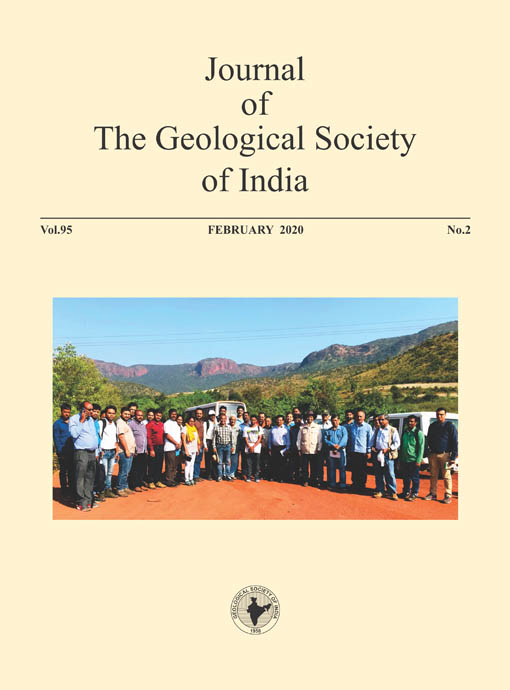Geochemical and Isotopic Composition of Gypsum Deposits from Sahastradhara Region of Lesser Himalaya, India
DOI:
https://doi.org/10.1007/s12594-020-1411-6Keywords:
No Keywords.Abstract
Major element chemistry of the gypsum mineralisation in the Himalayan region which represent the ancient seawater of the Tethys Sea. It provides the constraints on the change of global elemental and isotopic (87Sr/86Sr) variation over a geological time scale. Results indicate that these gypsum lenses, are formed by secondary process of leaching of host rocks and subsequent mineralization. These have close affinities with the seawaters and hence, may be a suitable proxy to represent the ancient seawater compositions. This information could be utilised to infer the paleooceanographic reconstruction of the Tethys Sea. As a part of this study, samples from Sahastradhara Lesser Himalaya were analysed for their geochemical and isotopic composition to infer about the chemical variation.Downloads
Metrics
Issue
Section
Downloads
Published
How to Cite
References
Aharon, P., Liew, T.C. (1992) An assessment of the Precambrian/Cambrian transition events on the basis of carbon isotope records. In: Schidlowski, M., et al. (Ed.), Early Organic Evolution Implication for Mineral and Energy Resources. Springer-Verlag, Berlin, pp.212-223.
Alibert, C., Michard, A. and Albarede, F. (1983) The transition from alkali basalts to kimberlites: Isotope and trace element evidence from melilitites. Contrib. Mineral. Petrol., v.82, pp.176-186.
Anantharaman, M.S. and Bahukhandi, P.C. (1984) A Study of the mineral resources of Mussoorie Syncline, Garhwal Lesser Himalaya. Current Trends in Geology, Sedimentary Geology of the Himalaya, v.5, pp.191-196.
Auden, J.B. (1937) The structure of the Himalaya and Garhwal. Rec. Geol. Surv. India, v.71, pp.407-433.
Auden, J.B. (1934) The geology of the Krol Belt. Rec. Geol. Surv. India, v.67, pp.357-454.
Banerjee (1997) Geochemical changes across the Proterozoic-Cambrian transition in the Durmala phosphorite mine section, Mussoorie Hills, Garhwal Himalaya, India. Palaeogeo., Palaeoclimat., Palaeoeco., v.132 pp.183-194.
Banner, J.L. (1995) Application of the isotope and trace element geochemistry of strontium to studies of diagenesis in carbonate systems. Sedimentology, v.42, pp.805-824.
Bhargava, O.N. (1972) The Reinterpretation of the Krol belt; Himalayan Geol., v.2, pp.47-81.
Biyani, A.K. (2006) Dimensions of Himalayan Geology, pp.4-5 Burns, S.J., Haudernschild, U., Matter, A. (1994) The strontium isotopic composition of carbonates from the Late Precambrian (Ca 560-540 Ma) Haqf Group of Oman. Chem. Geol., Isot. Geosci., Sect. iii, pp.69-282.
Elderfield, H. and Greaves, M.J. (1982) The rare earth elements in seawater. Nature, v.296, pp.214-219.
Ethington, R.L. (Eds.) Concepts and models of dolomitization. Soc. Econ. Paleontol. Mineral. Spec. Publ., no.28, pp.11-30.
Galy, A. and France-Lanord, C. (1999) Weathering processes in the Ganges-Brahmaputra basin and the riverine alkalinity budget. Chem. Geol., v.159, pp.31-60.
Ghosh, S.K. (1991) Paleoenvironmental analysis of the late Proterozoic Nagthat Formation NW Kumaun Lesser Himalaya. Sediment. Geol., v.71, pp.33-45.
Hanson, G.N. (1980) Rare earth elements in petrogenetic studies of igneous systems. Annu. Rev. Earth Planet. Sci., v.8, pp.371-406.
Mazumdar, A. (1999) Rare-earth elements and Stable Isotope Geochemistry of early Cambrian chert-phosphorite assemblages from the Lower Tal Formation of the Krol Belt_Lesser Himalaya, India. Chemical Geol., v.156, pp.275-297.
Mckenzie J.A., Hsu, K.J., Schneider, J.F. (1980) Movement of subsurface waters under the sabkha, Abu Dhabi, UAE, and its Relation to Evaporative Dolomite Genesis. SEPM Spec. Publ. DOI:10.2110/pec.80.28.0011.
Pierre, C. (1994) Stable isotope tracers of conditions of evaporates sedimentation and diagenesis. In: Technical Committee, GRECO (CNRS) (eds) Evaporite sequences in petroleum exploration, v.52, pp.145-160.
Prasad, B. and Dave,A. (2012).Society for petroleum Geophysicists (SPG) field Excursion Guide Geology of Lesser Himalaya Sequence in Mussoorie Syncline around Dehradun-Mussoorie area, pp.5-6.
Rai, S.K. and Singh, S.K. (2007) Temporal variation in Sr and 87Sr/86Sr of the Brahmaputra: Implications for annual fluxes and tracking flash floods through chemical and isotope composition. Geochem., Geophys., Geosystems, v.8(8), 14p.
Saini, N.K., Mukherjee, P.K., Rathi, M.S., Khanna, P.P., Purohit, K.K., (1998) A new geochemical Reference Sample of Granite (DG-H) from Dalhousie,Himachal Himalaya. Jour. Geol. Soc. India, v.52, pp.603-606.
Shannon, R.D. (1976) Revised effective ionic radii and systematic studies of interatomic distances in halides and chalcogenides. Acta Crystallogr., v.A32, pp.751-767.
Sharma, R. (2006) Sulphur isotopic study on barite mineralization of the Tons valley, Lesser Himalaya, India: Implication for source and formation process. Curr. Sci., v.90(3), pp.440-443.
Singh, P.S. and Singh, P.B. (2010) Geothermal evolution of the evaporite-bearing sequences of the Lesser Himalaya, India. Internat. Jour. Earth Sci. (Geol Rundsch), v.99, pp.101-108.
Singh, S.K. (1998) Chemical and strontium, oxygen, and carbon isotopic compositions of carbonates from the Lesser Himalaya: Implications to the strontium isotope composition of the source waters of the Ganga, Ghaghara, and the Indus rivers. Geochim. Cosmochim. Acta, v.62(5), pp.743-755.
Singh, I.B., Rai, V. and Bhargava, A.K. (1980) Some observations on the Sedimentology of the Krol succession of Mussoorie area, Uttar Pradesh. Jour. Geol. Soc. India, v.21, pp.232-238.
Taylor, S.R. and Mclennan, S.M. (1985) The continental crust: its composition and evolution. Blackwell, Oxford, 321p.
Tewari, V.C. and Qureshy M.F. (1985) Algal structures from the upper Krol-lower Tal Formations of Garhwal and Mussoorie synclines and their palaeo-environmental significance. Jour. Geol. Soc. India, v.26, pp.111-117.
Tewari, V.C.(1984) First record of conophyton Maslov from Krol Fromation of Mussoorie syncline and its significance on the age of thee Krol formation. Current Trends in Geology, Sedimentary Geology of the Himalaya, v.5, pp.203-207.
Tiwari, S.K., Rai, S.K., Bartarya, S.K., Gupta, A.K. and Negi, M., (2016) Stable isotopes (δ13C, δD, δ18O) and geochemical characteristics of geothermal springs of Ladakh and Himachal (India): Evidence for CO2 discharge in northwest Himalaya. Geothermics, v.64, pp.314-330.
Tucker, M.E. (1986) Formerly aragonitic limestones associated with tillites in the Late Proterozoic Kingston Peak Formation of Death Valley, California. Jour. Sediment. Petrol., v.56, pp.818-830.
Valdiya, K.S. (1980) The two intracrustal boundary thrusts of the Himalaya. Tectonophysics, v.66, pp.323-348.
Veizer, J. (1989) Strontium isotopes in seawater through time. Ann. Rev. Earth Planet. Sci., v.17, pp.141-167
Veizer, J., Compsten, W., Clauer, N., Schidlowski, M. (1983) 87Sr/86Sr in Late Proterozoic carbonates: evidence for a "Mantle" event at ≥900 ma ago. Geochim. Cosmochim. Acta, v.471, pp.295-302.

 Sakshi Maurya
Sakshi Maurya






